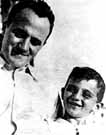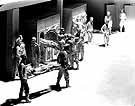
|
|
|

|

|

|

|
|
Click on an image to see a larger, more detailed picture.
|
|
|
|
|
| 1943: Death and Resistance |

|
pg. 495 |

|
|
|
|
| |
 Oneg Shabbat
Oneg Shabbat
Driven by the urgency to document the inhumanity of the Nazi attack on the Jews of Warsaw, Jewish historian Emanuel Ringelblum (pictured, left) initiated an effort to collect and preserve a documentary record of life within the walls of the ghetto. Under his leadership, a small group of writers, journalists, teachers, and students of history formed Oneg Shabbat (Sabbath Delight). This underground operation, code-named after the group's clandestine meetings on the Sabbath, created a secret archive chronicling the Jewish experience. Ringelblum's team encouraged the writing of memoirs and diaries. It collected underground materials such as ghetto newspapers, posters, announcements, photographs, and reports and statistics on the ghetto. The team also recorded testimonials of refugees arriving in Warsaw from other ghettos and camps. Ringelblum himself kept a diary of events. Oneg Shabbat archivists attempted to transmit documentary evidence to the West, although they stored most archival materials in three sealed milk cans, buried in separate locations. One can was discovered in 1946, another in 1950. The third, reportedly containing information on the resistance, has still not been found. Most members of the organization did not survive the deportations of 1942. Ringelblum hid in non-Jewish Warsaw until arrested on March 7, 1944, whereupon he and his family were executed.
Photo: Yad Vashem
|
 A scale model of crematorium II at Auschwitz-Birkenau, built and sculpted in 1991 by artist Mieczyslaw Stobierski, depicts the processing of victims. Individuals responsible for removing the bodies from the gas chambers, transporting them to the ovens, and burning the corpses were known as Sonderkommandos. Those selected for these ghastly tasks were given extra rations and were treated better than the average inmate. Every three or four months, the Sonderkommandos were sent to the gas chambers and processed precisely like the thousands of victims whom they had personally handled.
A scale model of crematorium II at Auschwitz-Birkenau, built and sculpted in 1991 by artist Mieczyslaw Stobierski, depicts the processing of victims. Individuals responsible for removing the bodies from the gas chambers, transporting them to the ovens, and burning the corpses were known as Sonderkommandos. Those selected for these ghastly tasks were given extra rations and were treated better than the average inmate. Every three or four months, the Sonderkommandos were sent to the gas chambers and processed precisely like the thousands of victims whom they had personally handled.
Photo: M. Stobierski / United States Holocaust Memorial Museum Photo Archive
|
 Karl Lowenstein, a Jew, was the head of the ghetto guard in Theresienstadt, the "model camp" near Prague, Czechoslovakia. Lowenstein enjoyed considerable power within the camp as the commander of some 400 young men. He clashed frequently with the ghetto's council over the privileges accorded to him and his men. Ultimately, Lowenstein's abuse of power led to his dismissal and imprisonment by the Nazi camp administration.
Karl Lowenstein, a Jew, was the head of the ghetto guard in Theresienstadt, the "model camp" near Prague, Czechoslovakia. Lowenstein enjoyed considerable power within the camp as the commander of some 400 young men. He clashed frequently with the ghetto's council over the privileges accorded to him and his men. Ultimately, Lowenstein's abuse of power led to his dismissal and imprisonment by the Nazi camp administration.
Photo: Terezin Memorial Museum / United States Holocaust Memorial Museum Photo Archive
|
|

|

|

|

|
 November 1, 1943: Joseph Stalin, Franklin Roosevelt, and Winston Churchill sign the Moscow Declaration. Because of British suspicions that the Jews and Poles are exaggerating German atrocities, the declaration omits references to gas chambers. Also, while promising postwar justice for murderers, it does not mention Jews.
November 1, 1943: Joseph Stalin, Franklin Roosevelt, and Winston Churchill sign the Moscow Declaration. Because of British suspicions that the Jews and Poles are exaggerating German atrocities, the declaration omits references to gas chambers. Also, while promising postwar justice for murderers, it does not mention Jews.
|
 November 3, 1943: Three hundred Jews at Borki, Poland, near Chelm, are put to work exhuming 30,000 corpses, mostly of Red Army POWs taken prisoner and murdered late in 1941. The bodies are burned on massive pyres.
November 3, 1943: Three hundred Jews at Borki, Poland, near Chelm, are put to work exhuming 30,000 corpses, mostly of Red Army POWs taken prisoner and murdered late in 1941. The bodies are burned on massive pyres.
|
 November 3, 1943: Jacob Katz, a Jewish cleaner at the Budzyn, Poland, concentration camp, rescues seven elderly Jews by hiding them beneath mattresses.
November 3, 1943: Jacob Katz, a Jewish cleaner at the Budzyn, Poland, concentration camp, rescues seven elderly Jews by hiding them beneath mattresses.
|
 November 3, 1943: Riccardo Pacifici, rabbi of Genoa, Italy, is deported to Auschwitz along with 200 members of his congregation and 100 Jewish refugees from Northern Europe.
November 3, 1943: Riccardo Pacifici, rabbi of Genoa, Italy, is deported to Auschwitz along with 200 members of his congregation and 100 Jewish refugees from Northern Europe.
|
 November 3, 1943: Anti-Nazi Catholic priest Bernhard Lichtenberg dies on his way to internment at the Dachau, Germany, concentration camp.
November 3, 1943: Anti-Nazi Catholic priest Bernhard Lichtenberg dies on his way to internment at the Dachau, Germany, concentration camp.
|
|
|
|
|
| 1943: Death and Resistance |

|
pg. 495 |

|
|
The Holocaust Chronicle
© 2009 Publications International, Ltd.
|
|
